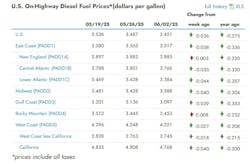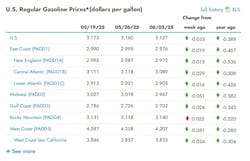National diesel and gas prices see slight decrease amid regional variability
Key takeaways:
- National diesel and gasoline prices have decreased, with diesel at $3.451 and gasoline at $3.127. Most U.S. regions saw declines, especially in the Midwest.
- Diesel prices range from $3.097 in the Gulf Coast to $4.221 on the West Coast, while gasoline prices vary from $2.702 in the Gulf Coast to $4.207 on the West Coast.
- Current prices are lower than last summer, but the Atlantic hurricane season may disrupt supply chains and lead to possible price hikes.
Most regions of the U.S. saw declines in diesel and gasoline prices this week. According to data released by the U.S. Energy Information Administration on June 3, the national average on-highway diesel price decreased 4 cents to $3.451. Gas prices dropped 3 cents to $3.127.
What are the current diesel prices across the U.S.?
Here are this week’s diesel price highlights from each region of the U.S.:
- Midwest: With a drop of 4 cents to $3.388, the Midwest experienced the largest drop in diesel prices this week.
- Gulf Coast: The price of diesel along the Gulf Coast fell by 4 cents to $3.097.
- East Coast: Diesel prices on the East Coast dropped 4 cents to $3.517.
- West Coast: The West Coast region saw diesel prices drop 3 cents to $4.221. Without including California, prices dropped 2 cents to $3.745.
- Rocky Mountain: In the Rockies, diesel prices rose 1 cent to $3.453.
According to AAA Motor Club, the current national diesel price average is $3.515. This is 6 cents higher than EIA’s current estimate and 33 cents lower than this time last year.
See also: Nationwide fuel prices see slight decline
What are the current gasoline prices across the U.S.?
EIA reports that the current national average on-highway gasoline price is $3.127, 3 cents lower than last week.
Here are this week’s gasoline price highlights from each region of the U.S.:
- Midwest: The biggest drop in gasoline prices this week was in the Midwest with 5 cents to $2.967.
- West Coast: Along the West Coast, gas prices dropped 5 cents to $4.207. Without including California, prices dropped 2 cents to $3.833.
- Gulf Coast: Along the Gulf Coast, gas prices dropped 2 cents to $2.702.
- East Coast: In the East Coast region, gas prices dropped 2 cents to $2.976.
- Rocky Mountain: Gas prices in the Rockies increased 2 cents to $3.140.
According to AAA, the current national gasoline price average is $3.137. This is 1 cent higher than EIA’s current estimate and 40 cents lower than this time last year.
In a recent press release, AAA said, “While fuel prices are expected to remain on the lower side compared to last summer, weather is the wild card. The Atlantic hurricane season begins Sunday, and NOAA predicts a 60% chance of an above-normal season. Storms along the Gulf Coast can affect oil refineries and disrupt fuel deliveries, leading to a temporary increase in gas prices.”
About the Author

Jenna Hume
Digital Editor
Digital Editor Jenna Hume joined FleetOwner in November of 2023 and previously worked as a writer in the gaming industry. She has a bachelor of fine arts degree in creative writing from Truman State University and a master of fine arts degree in writing from Lindenwood University. She is currently based in Missouri.


